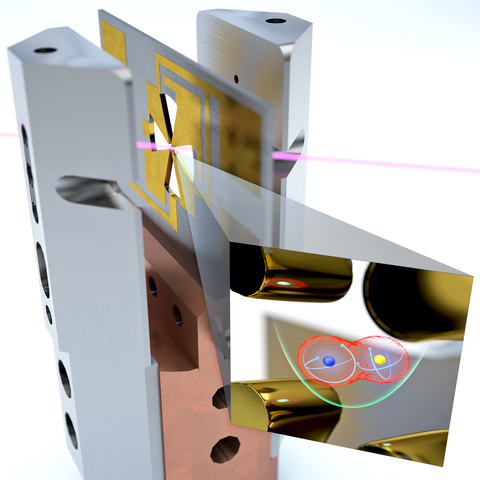Summary
The pursuit of fundamental limits in frequency metrology has historically motivated the development of groundbreaking techniques such as laser cooling and spin-squeezing. Our research focuses on the use of trapped ions for optical frequency metrology and the development of quantum-limited techniques for high-accuracy measurements. We target applications from atomic clocks to tests of fundamental physics and relativistic geodesy.
Below are descriptions of our experiments and links to some key publications. Contact information for any current member of the group is available in the Time and Frequency Division Staff Listing.
Description

This project uses techniques from quantum information science to enable precision metrology. We use the dipole-forbidden 1S0 - 3P0 transition in singly-ionized aluminum as an stable frequency reference (natural linewidth ~8 mHz), which we detect using quantum logic spectroscopy with a second ion held in the same trap [1]. Current efforts focus on reducing systematic effects, such as relativistic shifts due to time dilation, and increasing clock stability by use of quantum entanglement and classical correlations. For example, probing two separate clocks in a correlated manner enables clock interrogation beyond the coherence limits of the probe laser and approaching the lifetime limit of the clock transition [2-3]. These clocks have demonstrated state-of-the-art accuracy for optical clock measurements worldwide [4], with the current generation reaching fractional uncertainty below 1x10-18 [5, 6].
[1] P. O. Schmidt et al., "Spectroscopy using quantum logic", Science 309, 749-752 (2005)
[2] E. R. Clements et al., "Lifetime-limited interrogation of two independent 27Al+ clocks using correlation spectroscopy", Phys. Rev. Lett. 125, 243602 (2020)
[3] M. E. Kim et al., "Improved interspecies optical clock comparisons through differential spectroscopy", Nat. Phys. 19, 25 (2022)
[4] Beloy et al. (BACON Collaboration), "Frequency Ratio Measurements at 18-digit accuracy using an optical clock network", Nature 591, 564 (2021)
[5] S. M. Brewer et al., "27Al+ quantum-logic clock with systematic uncertainty below 10-18", Phys. Rev. Lett. 123, 033201 (2019)
[6] M. C. Marshall et al., "High-Stability Single-Ion Clock with 5.5×10−19 Systematic Uncertainty" Phys. Rev. Lett. 135, 033201 (2025)
Personnel
Permanent staff: David Hume, Chin-Wen (James) Chou, Mason Marshall
Graduate students: Daniel Rodriguez Castillo, Willa Dworschack, Addison Hartman

